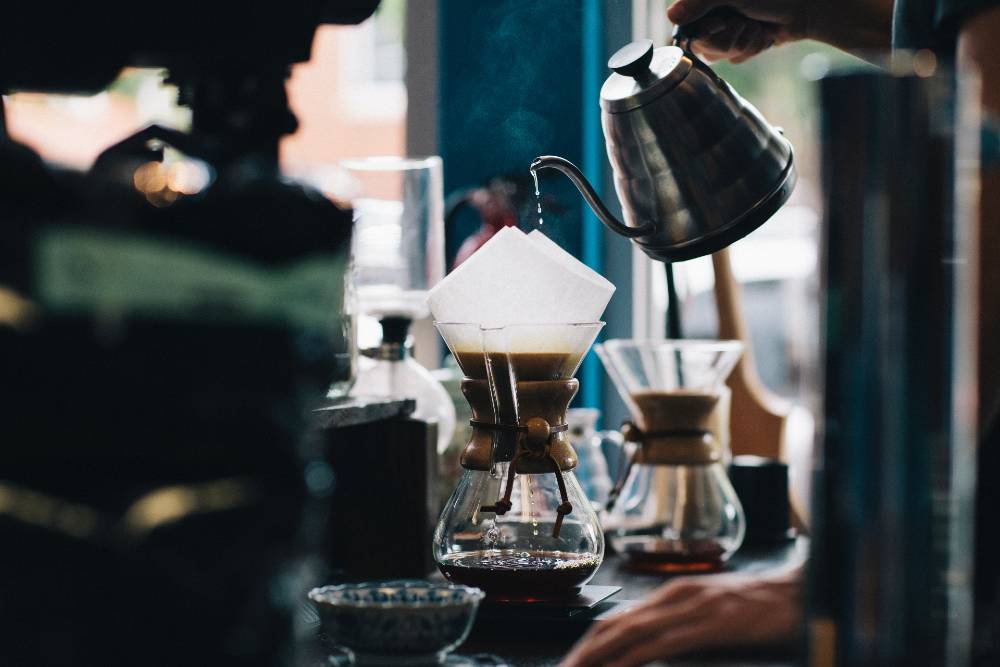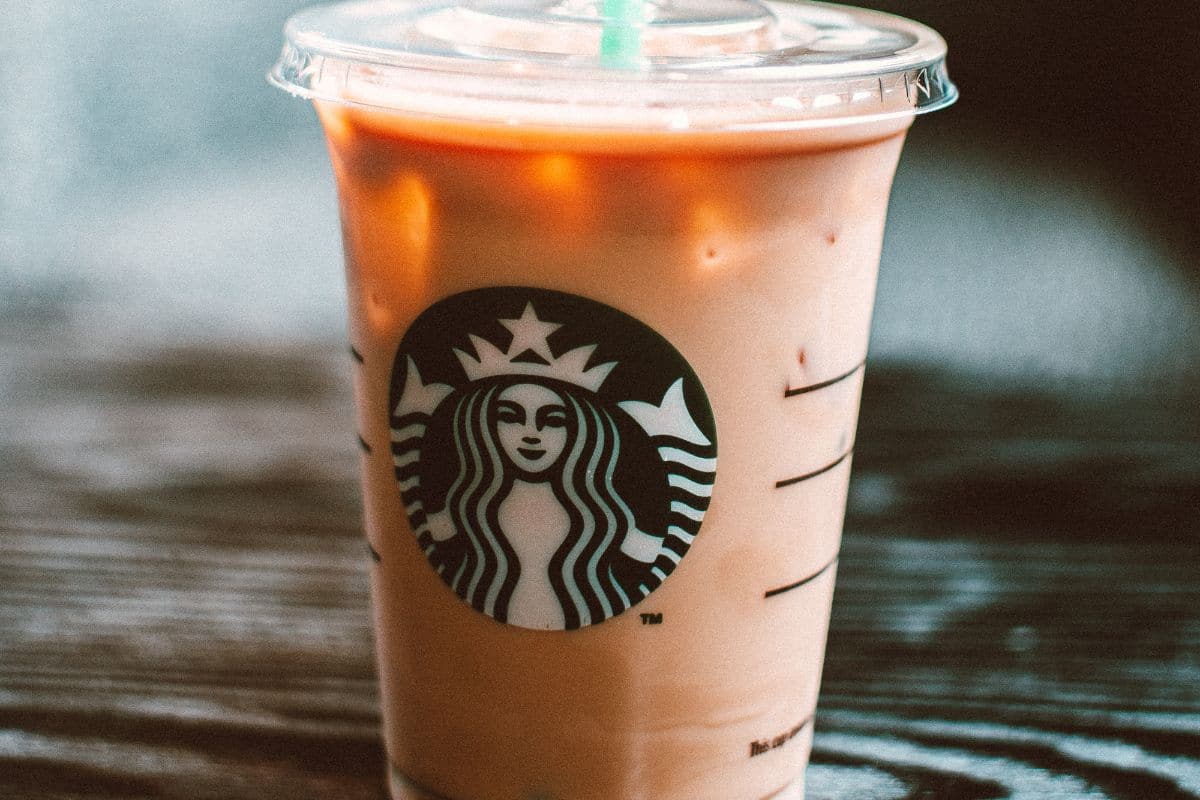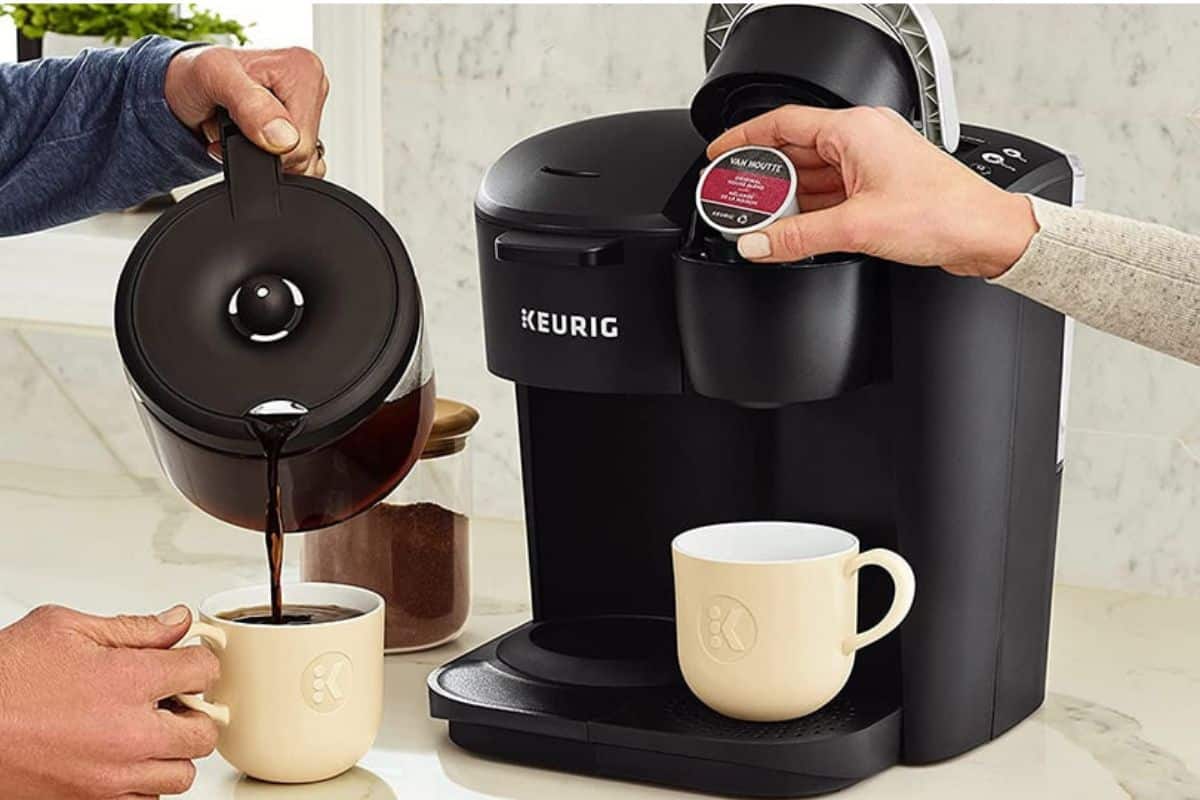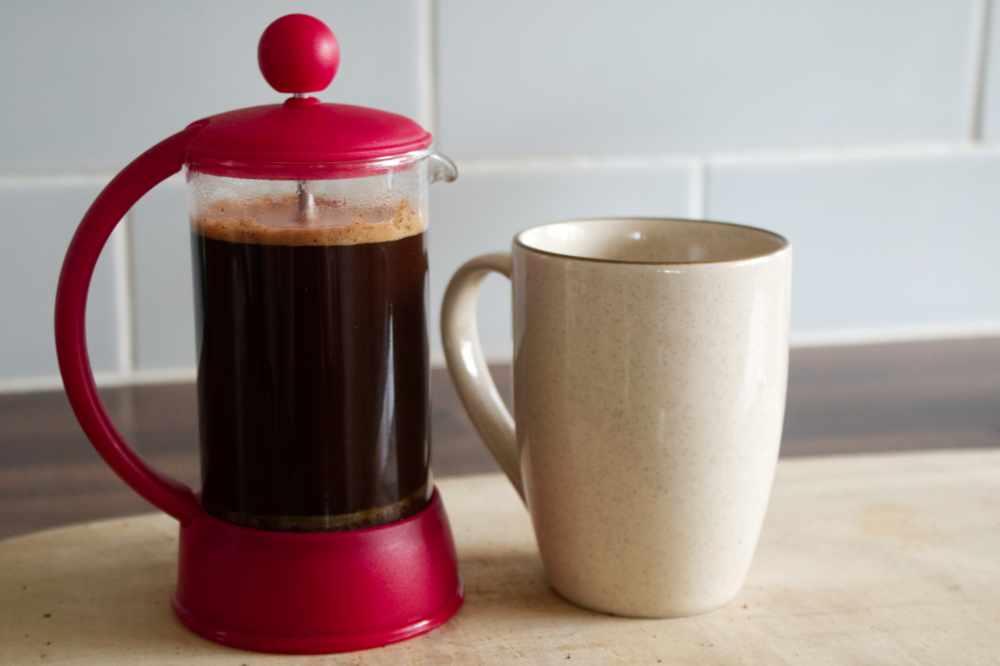Manual coffee brewing methods, such as pour-over coffee, have become one of the most common coffee brewing methods worldwide. Not only can pour-over coffee be one of the tastiest cups of coffee, but it is also one of the cheapest, most affordable, methods to get started with.
Unfortunately, some people get put off when they try making it for the first time; they’ll buy a bag of pre-ground coffee, load some coffee into the filter, and pour some water over the grounds. What these first-timers haven’t been told, is that their coffee beans need to be ground to a certain size and weighed out.
The best grind size for pour over coffee is a medium grind. A medium coffee grind has particle sizes around 1/16”.
We also have a grind size chart on our Cheat sheet which you can download by signing up for Moka Pot Mondays our coffee newsletter below.
Use a burr grinder to get the grind size just right, measure out your beans, use the right amount of water at the right temperature and, I promise, you will have just made one of the best mugs of coffee you’ve ever tasted.

What Is Pour Over Coffee?
Pour-over coffee is one of the simplest ways to brew coffee. It is sometimes also called manual brewing, hand brewing, filter, or even just drip.
It’s where you load your coffee grounds into a filter, and pour hot water over the grounds. The hot water infuses with the coffee grounds and dribbles out into your mug.
It’s pretty much the same way that a drip machine brews coffee, except you do it all yourself.
Although there is evidence that people have been brewing long before, it was officially invented back in the early 1900s, in Germany, by a lady named Melitta Bentz who filed patents for her dripper designs. Her company is what became the same Melitta that produce paper coffee filters in supermarkets worldwide.
How To Grind
It can be tricky to describe the size of grind that’s ideal for pour over coffee.
To give a fast description; pour over coffee needs a medium grind.
But what is a medium grind?
It’s fairly common to describe the perfect grind for pour over coffee as rough sand or even as table salt. Really, a description for a medium grind could be more helpful than salt or sand.
While there are opinions far and wide of the best grind size for pour over coffee, the final decision is always down to your own personal preference. If you like the brew that comes from a super fine or super coarse grind, then who am I to stop you?
To get technical though; in general, most people will find the perfect grind size for pour over coffee is with particle sizes around 1/16”. To get even more technical, I would say 1/16” ± 1/32”.
I know not everyone is a maths nerd like me, so I’ll say that in human language. The ideal grind size for pour-over coffee is around one-sixteenth of an inch, give or take half that size.
Why Brew Pour Over?
While different brew methods don’t affect the flavor of the coffee bean itself, different brew methods do chance how the coffee flavors are extracted.
Every brew method extracts coffee in its own different, unique, way.
Pour over is a great way to really let all of the interesting, intricate, flavors in the coffee bean shine through. The filter holds on to oils and unwanted grounds, so you get a very smooth brew with minimal bitterness.
To give a description of the taste of pour over coffee, well, I’m sure you’ve tried some drip coffee before? It’s like really tasty drip coffee.
What Equipment Do You Need?
While you can absolutely go all out and make sure you’ve got all of the gear for your pour over set up, really, you can make a damn good mug of coffee with just a cheap and cheerful filter cone or V60.
With that said, if you’re hunting for the absolute best pour over possible, then investing in good coffee gear will make it easy to tweak all of the little nuanced factors that go into your humble cup of Joe.
The Brewer
It can be a simple, cheap and cheerful, filter cone style brewer such as The Hario V60 or Kalita Wave. Or it can be as premium as the gorgeous Chemex. Anything that will support a wet filter full of coffee grounds will do the trick.
With pour over, the brewer gadget certainly is important, you can’t brew without it, but it’s not the part that makes all the difference to the coffee. That part is you.
Filters
When it comes to choosing your filter, in general, the voice is between paper filters and reusable filters.
With paper filters, you have the choice of either bleached (white) filters, and unbleached (brown) filters. The only difference here, other than color, is that you might want to gently rinse the unbleached filters under a tap before you use them to remove a papery taste.
While there is a choice of white or brown, paper filters do also come in different sizes.
With reusable filters, well, they’re reusable. You clean the used coffee grounds after you’re finished brewing. There are many different choices of reusable filters, they can be made from plastic and all kinds of metal such as stainless steel, copper, and even gold.
Kettle
The ideal kind of kettle for pour over is a gooseneck kettle. They have a long, narrow, curved spout that helps to give you optimum control over how you pour.
While you absolutely can use a regular kettle, a saucepan on a stove, or even just a jug from a microwave, you will definitely get your best pour over coffee results from using a gooseneck kettle.
The extra control that a gooseneck kettle will give you will result in brewing a much better coffee, consistently.
Scales
Making coffee is like making a cake, you follow a recipe. While they’re very different recipes, you want to be very careful that you use the correct amount of ingredients, and in the correct proportions, or else your cake just won’t turn out right.
So why should coffee be any different just because it’s a simpler recipe?
The recipe for coffee is usually described as a ratio, grams of coffee per millilitres (or grams) of water. It is also called the golden ratio of coffee
Many different places will recommend different coffee to water ratios. The actual coffee to water ratio you use will depend purely on your own preference. You might also find that different ratios work better for different brew styles..
Some people will recommend going for a 1:18 ratio, other places will recommend a 1:12 ratio. Personally, I usually like a 1:15 ratio. That’s 1 gram of coffee per 15 millilitres (or grams) of water.
How do you ensure you’re brewing to this ratio? Coffee scales.
While you absolutely can use an ordinary set of kitchen scales, they are often not very sensitive around the 10s of grams range. For example, a digital set of kitchen scales will measure in increments of 1 gram.
A set of coffee scales will typically be able to measure in increments of 0.1 grams. That’s 10 times more sensitivity. That is, provided the number it displays is actually representative of the mass on the balance.
To be confident in your coffee measurement, you need a good quality set of coffee scales.
Grinder
No matter which brew method you choose, pour over or otherwise; having your coffee beans ground to just the right size for your brewing method, will give you the best coffee possible.
Why does coffee need to be gound to a certain size?
Did you ever take a highschool chemistry class? Do you remember the little trinket of info where finer powders will react quicker? The same goes for coffee.
Different brew methods need different grind sizes because different brew methods take different lengths of time.
How can I control the size I grind coffee to?
You need a burr grinder to control your coffee grind size.
There are two types of coffee grinders; blade grinders and coffee grinders. A blade grinder will chop randomly at the beans until they can’t be chopped any more. A burr grinder will crush beans down to a certain size depending on the distance between the grinding burrs.
So a burr grinder can grind coffee beans to different sizes just by moving the burrs closer or further apart.
Which Coffee Should You Use?
Generally speaking, most people find a medium roast will work best for your pour over. That said, there are plenty of dark roasts and light roasts alike that make brilliant pour over coffee.
The real secret to great coffee beans is getting them freshly roasted from a great roaster.
Small-batch coffee roasters are popping up in small towns all around the world. They offer unique coffee blends, roasts, and strains that you just won’t find in supermarkets. Most importantly, you know that your beans have been freshly roasted because they usually put the roast date on the bag.
The sweet spot with roasting is between 1 to 2 weeks after roasting. That’s when you get the best flavor.
You can absolutely use the beans after 2 weeks, but after months they will become stale. It’s probably best to not use them too soon though. They release CO2 for a few days after roasting, so that gives them time to offgas.
The key though, is to get the beans fresh.
Brewing Tips
Coffee To Water Ratio (The Golden Ratio)
The perfect ratio of coffee to water is called The Golden Ratio of Coffee. The silly part is, this ratio is different for everyone.
The ratio is usually measured in grams of coffee per millilitres (or grams) of water.
If you ask different coffee places what the perfect coffee ratio is, you will get a wide range of answers. Some will say a ratio of 1:12 is the way, others will say 1:18 is the rule.
The truth is, the perfect ratio depends on your own preference. Personally, I’ve found that 1:15 is for me.
The Perfect Brewing Temperature
If you brew at too high of a temperature, you will get a harsh and bitter coffee. If you brew at too low of a temperature, you will get a weak and thin coffee. The temperature has to be just right to make the perfect brew.
The perfect brewing temperature of coffee is between 195°F and 205°F.
The Bloom
Coffee is like a flower, you’ve gotta let it bloom.
Have you ever noticed the little bubbles that appear on the top of coffee grounds when you add water? Those bubbles are called the bloom.
The bubbles come from CO2 being released from your coffee grounds when water is added.
To reduce bitterness in your coffee, allow these bubbles to disappear.
Begin by adding a little bit of water to your pour over to allow the grounds to soak, they will start to bubble up. Wait and let the bubbles pass. Then continue pouring over your pour over.
Pouring Technique
Exactly how you pour water over your coffee seriously influences how your brew turns out.
If you only pour into the middle, coffee grounds will shift toward the edges and your brew will not extract properly. If you only pour at the edges, the water will flow down the side of your filter and miss lots of the beans, also not extracting properly.
The perfect pour over pouring technique will take some playing to find what works best for you.
Personally, I’ve found that making little figures of 8 over the coffee grounds tends to do the trick for me.
Why Not Buy Pre-Ground Coffee?
Now, I’m not saying for a second that pre-ground coffee won’t make you a good brew. You absolutely can get a nice cup of coffee from pre-ground.
There are two main downsides pre-ground coffee.
- It is already ground to a certain size. For the tastiest cup possible, you want to use a particular grind size for the particular brewing method you are using.
- Pre-ground is not as tasty and it goes stale quicker. Whole beans, that have just been freshly ground bring a whole new dimension of freshness and flavor to your coffee.
The upside to preground? It’s easy.
Final Thoughts
Hopefully this guide has been pretty thorough in not only explaining the best grind size for pour over coffee, but also just how to make the absolute best cup of Joe possible.
While you absolutely can just throw any amount of coffee into your filter, pour some water over it, and you’ve got some Java; you’re leaving a lot to chance by doing that.
Sure, you might hit it lucky and make that amazing mug by chance. Is it not better to take your time, get it right, make an amazing coffee, and be able to do that every time you brew?
I certainly choose an amazing coffee everytime. You could have some cake with it and eat it too.
Related Reading
Chemex vs V60 (Powerful Pour-Over Potions)
Best Automatic Pour Over Coffee Makers – An Expert Buyer’s Guide
Krups GVX2 Burr Grinder Review
Best Reusable & Paper Coffee Filters – For Every Machine & Brew Type
Best Chemex Alternatives – An Expert Buyer’s Guide
Best Coffee Ratio for Pour Over Brews
Best Ceramic Pour Over Coffee Makers





